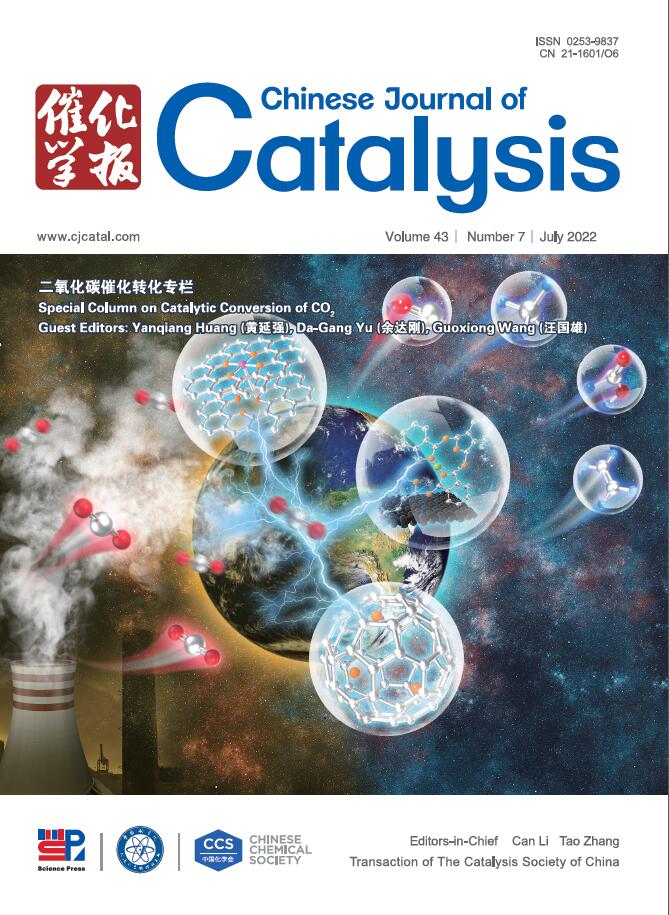废PET在不良磺化uio - 66defs - so3h负载Ru催化剂上催化升级为1,4-二羧酸二甲基环己烷
IF 15.7
1区 化学
Q1 CHEMISTRY, APPLIED
引用次数: 0
摘要
聚乙二醇-co-1,4-环己二甲醇对苯二甲酸乙二醇酯(PETG)比传统的聚对苯二甲酸乙二醇酯(PET)具有更好的性能和稳定性。然而,昂贵的单体(1,4-环己二甲醇,CHDM)限制了PETG的生产和应用。将废PET直接升级为二甲基环己烷-1,4-二羧酸二甲酯(DMCD)可促进CHDM的大规模生产。本文合成了Ru/ uuo -66def- so3h双功能催化剂,并在温和条件下将其应用于废PET的耦合甲醇解制对苯二甲酸二甲酯(DMT)和DMT加氢制DMCD。表征结果表明,与Ru/UiO-66相比,Ru/ uio - 66defs - so3h具有介孔(主要通道为2.72和3.44 nm),表面积增大(998 m2·g-1),酸性增强(580 μmol·g-1), Ru纳米颗粒(NPs)分散性高(45.1%)。这些综合优势可以同时加速甲醇分解和加氢反应,促进PET直接升级为DMCD的性能,特别是在170℃、3 MPa H2条件下,6 h内,Ru/ uiu -66def- so3h的PET转化率和DMCD收率分别达到100%和97.7%,并且Ru/ uiu -66def- so3h还可以将废弃PET基产品(包括饮料瓶、纺织纤维和包装膜)升级为DMCD。本文章由计算机程序翻译,如有差异,请以英文原文为准。
Catalytic upgrading of waste PET to dimethyl cyclohexane-1,4-dicarboxylate over defective sulfonated UiO-66def-SO3H supported Ru catalyst
Poly(ethylene glycol-co-1,4-cyclohexanedimethanol terephthalate) (PETG) possesses excellent properties and stability than traditional poly(ethylene terephthalate) (PET). However, the production and application of PETG are restricted by the expensive monomer (1,4-cyclohexanedimethanol, CHDM). Direct upgrading of waste PET to dimethyl cyclohexane-1,4-dicarboxylate (DMCD) can promote the production of CHDM in large scale. In this work, a bifunctional Ru/UiO-66def-SO3H catalyst was synthesized and utilized in coupled methanolysis (of waste PET to dimethyl terephthalate (DMT)) and hydrogenation (of DMT to DMCD) under mild condition. Characterizations revealed that Ru/UiO-66def-SO3H possessed mesopores (dominant channels of 2.72 and 3.44 nm), enlarged surface area (998 m2·g–1), enhanced acidity (580 μmol·g–1), and Ru nanoparticles (NPs) dispersed highly (45.1%) compared to those of Ru/UiO-66. These combined advantages could accelerate the methanolysis and hydrogenation reactions simultaneously, promoting the performance of direct upgrading of PET to DMCD in one pot. In particular, the conversion of PET and yield of DMCD over Ru/UiO-66def-SO3H reached 100% and 97.7% at 170 °C and 3 MPa H2 within 6 h. Moreover, Ru/UiO-66def-SO3H was also capable for the upcycling of waste PET-based products including beverage bottles, textile fiber and packaging film to DMCD.
求助全文
通过发布文献求助,成功后即可免费获取论文全文。
去求助
来源期刊

Chinese Journal of Catalysis
工程技术-工程:化工
CiteScore
25.80
自引率
10.30%
发文量
235
审稿时长
1.2 months
期刊介绍:
The journal covers a broad scope, encompassing new trends in catalysis for applications in energy production, environmental protection, and the preparation of materials, petroleum chemicals, and fine chemicals. It explores the scientific foundation for preparing and activating catalysts of commercial interest, emphasizing representative models.The focus includes spectroscopic methods for structural characterization, especially in situ techniques, as well as new theoretical methods with practical impact in catalysis and catalytic reactions.The journal delves into the relationship between homogeneous and heterogeneous catalysis and includes theoretical studies on the structure and reactivity of catalysts.Additionally, contributions on photocatalysis, biocatalysis, surface science, and catalysis-related chemical kinetics are welcomed.
 求助内容:
求助内容: 应助结果提醒方式:
应助结果提醒方式:


